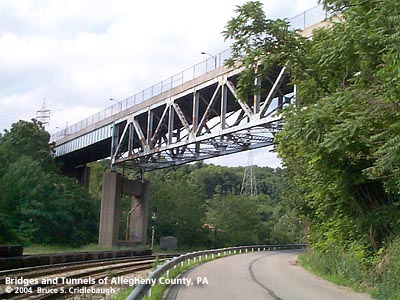| Home > All By Location regional map > McKeesport > Homeville Rd Viaduct over Thompson Run | |||
|
|

View north (downstream) toward Monongahela River More detail photos OFFICIAL NAME: Homeville Road - Section 2; Bridge No. 5, Thompson Run S.S. OTHER DESIGNATION: Homeville Rd Viaduct Homeville Rd over Thompson Run mcke595-1 LOCATION: West Mifflin USGS 7.5" Topo Quad - UTM Coordinates: McKeesport - Zone 17; 0595-4469 CARRIES: Homeville Rd BETWEEN: -- Grant Av; Grant Av Extension -- Lower Bull Run Rd CROSSES: -- Thompson Run (tributary of Monongahela River) -- Union RR -- Grant Av TYPE OF CONSTRUCTION / DESIGN: Steel deck truss LENGTH OF MAIN SPAN: TOTAL LENGTH (including longest elevated ramp): 779 ft HEIGHT OF DECK: YEAR ERECTED / ENGINEER: 1955, Allegheny County ADDITIONAL INFO: The Homeville Road Viaduct crosses the Union Railroad just to the south of Mifflin Mine Station, the southern limit of the URR Duquesne yard. The URR follows the valleys of two different streams, each named Thompson Run. North of the Monongahela River is Thompson Run, a tributary of Turtle Creek, which in turn flows into the Monongahela River at the USS Edgar Thomson Works in Braddock. Opposite this point, another Thompson Run, having a watershed largely in West Mifflin, flows directly into the Monongahela River. Metal builder's plaques are mounted on the northern railing at each end of the bridge:
from the PennDOT Historic Bridge Survey: The 8-span, 779'-long bridge built in 1955 consists of a 218'-long Warren deck truss span flanked by three built-up deck girder approach spans to its north (102', 101', 123'), and four built-up deck girder approach spans to its south (65', 66', 66', 42'). The bridge is supported on concrete abutments and concrete column and cap bents. A sidewalk with a metal railing is cantilevered from the east side. The rivet-connected truss bridge is composed of standard members with rolled sections for the verticals and diagonals. It has no unusual or noteworthy features, and is a late example of a truss design that was commonplace by the first decade of the 20th century. It is not historically or technologically distinguished by its setting or context. Built by the county in 1955 to improve a local road, the bridge does not have a significant historic association with the PHMC-determined eligible Union RR, developed from 1894 to 1907. The bridge carries a two lane road and one sidewalk over a ravine with four tracks of the Union RR, two local roads (Lower Bull Run Road and Grant Avenue Extension) and a stream. The setting is wooded with no development adjacent to the bridge. The surrounding area is dominated by a mix of 20th-century residences and businesses. The Union RR, a subsidiary of US Steel, was the company's intra-plant railroad constructed from 1894-1907. The line's r-o-w has been determined eligible by PHMC (DOE 1998). from Transtar website (owner of Union Railroad): The railroad, as it exists today, has resulted from the union of all or parts of five railroads between the years 1906 and 1915. The first addition occurred in 1906 when a portion of the Pittsburgh, Bessemer and Lake Erie Railroad, extending from North Bessemer to East Pittsburgh, was leased to the Union Railroad. Later in 1906, the railroad leased the Monongahela Southern Railroad. The next addition involved the St. Clair Terminal Railroad in 1920. All three properties were subsequently merged. The last addition occurred in 1915 with the lease of track from Duquesne to McKeesport via the Penn Central Bridge. The original URR extended from East Pittsburgh to Hays, a distance of six miles, and was constructed in the years 1894-1907. During the same period, 13 branches, with an aggregate length of 14 miles were built. Operations began on June 1, 1896, with 241 employees, 25 steam locomotives and no cars. On October 26, 1897, the first train was interchanged with the Pittsburgh, Bessemer & Lake Erie Railroad at East Pittsburgh. This 30-car ore train from North Bessemer was consigned to Edgar Thomson. The Monongahela Southern Railroad extended from a point underneath the street railway bridge on Duquesne Boulevard, Duquesne, to Mifflin Junction. The railroad was placed in operation as it was built beginning in 1898. It was used for the disposition of hot slag and waste materials until June 17, 1906, when the first interchange of traffic occurred with the Wabash, Pittsburgh Terminal Railway. (The latter) railway was later known as the Pittsburgh and West Virginia Railway, until merged with the Norfolk-Western Railway. The Clairton Branch of the Monongahela Southern Railroad was constructed between the years 1917- 1920. It extended from Clairton Junction (Bull Run) to a connection with the St. Clair Terminal Railroad in Clairton and was first opened to operations on April 14, 1919. The St. Clair Terminal Railroad began at the connection with the Monongahela Southern Railroad in Clairton, and extended approximately 4-1/2 miles to the end of the Clairton Steel Works, and to Wylie. FIELD CHECKED: 13-Jun-2004 INFO SOURCES: field check; Union Railroad website; PennDOT Historic Bridge Survey Submit info or inquiry - share some facts or ask a question. Introduction -- Nearby Structures Page created: Last modified: 23-Jun-2004 |
View Larger Map View Larger Map View Larger Map 
| |
| copyright: © Bruce S. Cridlebaugh 1999-2008 All Rights Reserved | |||